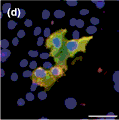Chemistry, Department of: Faculty Series

Ronald Cerny Publications
Document Type
Article
Date of this Version
6-1-2004
Abstract
There are many similarities between the interactions of environmental protozoa with pathogenic bacterial species and those observed in mammalian macrophages. Since single-celled protozoa predate mammalian hosts, it is likely that interactions in environmental biofilms have selected for many of the bacterial virulence mechanisms responsible for human disease. In order to better understand bacterial-phagocyte interactions, we developed a selection for Acanthamoeba castellanii variants that are more resistant to killing by bacterial pathogens. We identified four amoebal clones that display decreased phagocytosis of bacteria but no difference in uptake of latex beads compared to wild-type amoebae. These amoebal variants display differences in cellular morphology, partial resistance to killing by bacteria, more bactericidal activity, and higher frequencies of lysosome fusion with the bacterial vacuole. Three proteins are present at lower levels in these variants than in wild-type amoebae, and matrix-assisted laser desorption ionization–time of flight mass spectrometry allowed identification of two of them as actin and hsp90. We found that specific inhibitors of hsp90 produce a similar phenotypic effect in macrophages. These data suggest that hsp90 plays a role in phagocytic and, possibly, bactericidal pathways that affect interactions of phagocytic cells with bacteria.


Comments
EUKARYOTIC CELL, June 2004, p. 567–578 Vol. 3, No. 3. Copyright © 2004, American Society for Microbiology. Permission to use.